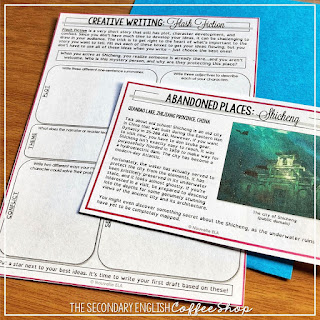Creative Writing Prompts Across Your Curriculum
How do you teach creative writing in middle and high school, when there’s so much else to be done? There’s so much pressure to teach other skills that it can be difficult to find time for creative writing activities. Here are some ways to incorporate creative writing prompts as you hit your standards.
Hey, y’all! It’s Danielle from Nouvelle ELA! Today, I’ll share activities for teaching creative writing that show understanding of other ELA topics and skills. This is one of my favorite ways to get students out of a “rut” on a particular topic and instill a sense of fun into my lessons. Kids love creative writing, but it often gets lost in the shuffle.
Build Classroom Community with Creative Writing Activities
Since creative writing can be so fun, the stakes feel low to students. Shy students can display their senses of humor and otherwise reluctant students can buy into an activity. That’s why I love to use creative writing prompts to build classroom community and collaboration.
One of my favorite writing activities is this Round Robin. Students work together to write a timed story. This is fun because it helps them stop self-censoring so much (or else they’ll run out of time!). This activity is scaffolded with an introduction to the “Somebody Wanted But So Then” (SWBST) structure. That means that students are practicing writing, having fun with each other, AND reinforcing their story structure skills. Awesome!
Also on this blog: Building Collaboration and Critical Thinking
Using Nonfiction to Inspire Creative Writing
Writing activities are also an excellent way for students to react to nonfiction and extend their understanding of a topic. While students need to write analytical responses as well, creative writing prompts can be an outlet for students to process an informational text.
Consider starting with a nonfiction list, like 10 Abandoned Places or 10 Maritime Mysteries, and having students do some creative writing after they read. For example, with Abandoned Places, students can choose to set a story in one of the places. Both of these resources are an opportunity to share writing prompts with pictures, and students LOVE PICTURES.
You can grab a sample of the Abandoned Places activity here, including a free brainstorming worksheet for writing a short story.
Also on this blog: Using Nonfiction to Engage Reluctant Readers
Connecting to Literature through Creative Writing
I also love using creative writing prompts to help students engage in literature. This approach helps students think more critically about what they’re reading and gives them some ownership over the story.
When I introduce any Shakespeare play, I have students write Shakespeare a friendly letter introducing him to one of our modern technologies. One of my favorite letters a student has ever written described text messaging as “an invisible message delivered by an invisible rider on an invisible horse.” How creative!
I’ve also had students use creative writing to make a major change to a story. This is an excellent way to highlight the author’s craft and purpose. For example, students can rewrite the ending of Much Ado About Nothing as a tragedy to help understand how Shakespeare crafts an ending. They can rewrite a spooky story like “The Monkey’s Paw” in a different mood to help deepen their understanding of mood and tone.
Teaching creative writing doesn’t have to be a “stop everything and write fiction.” It can be woven throughout your curriculum. While each piece of writing is its own text, you can use writing as a tool for demonstrating understanding of any other text.
Also on this blog: 4 Creative Reading Activities to Spark Engagement
Deepen an Understanding of Poetry
Poetry can be intimidating for students, so I like to try as many approaches as possible to aid in engagement. One way I help my students access poetry is through creative writing. Snippets of poetry and song lyrics become creative writing prompts to inspire short stories.
Also on this blog: 3 Ways to Teach Creative Writing Anytime
Key Takeaways
Students should write often - both creatively and analytically
Align creative writing opportunities with other standards and learning targets
Lower the stakes by using collaborative or timed writing
You don’t need a whole Creative Writing Unit to leverage the power of this type of writing activity. Instead, you can use it as one type of student response.
What are some ways you get “creative” with creative writing? Let us know in comments or on Instagram!
Check out these Creative Writing Activities from other Coffee Shop teachers:
- Creative Writing Assignments Inspired by YA Lit by Room 213
- 5 Fun Creative Writing Exercises (blog post) by The Daring English Teacher
- Creative Writing Activities for any novel or short story by Tracee Orman
- Writing a Tabloid Article by Addie Williams
- Writing Challenges by Presto Plans
Happy teaching!


















